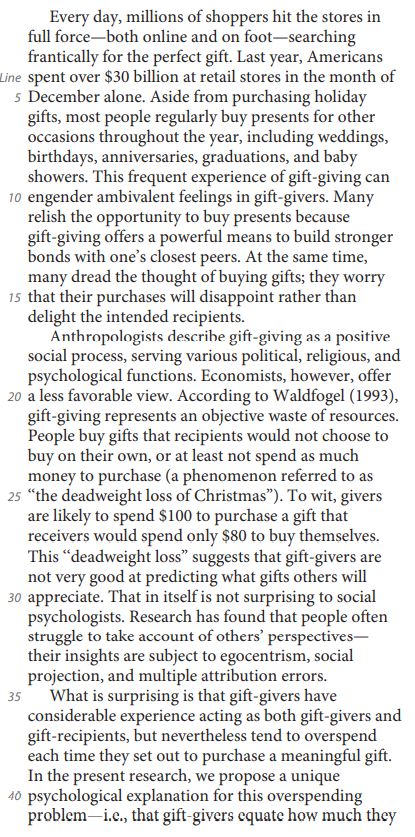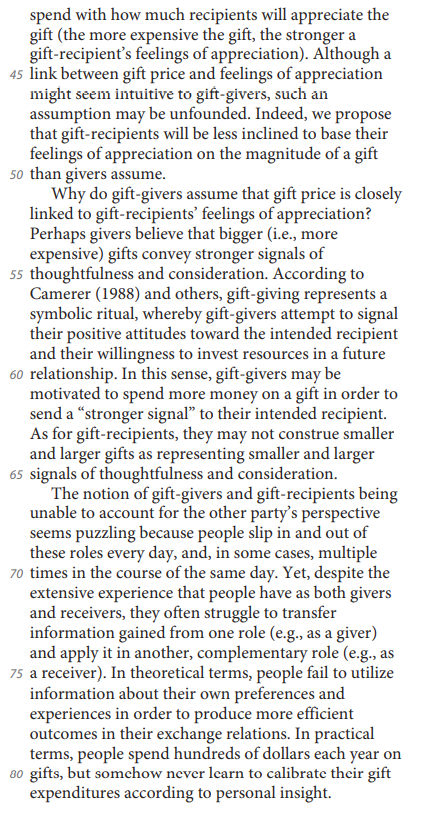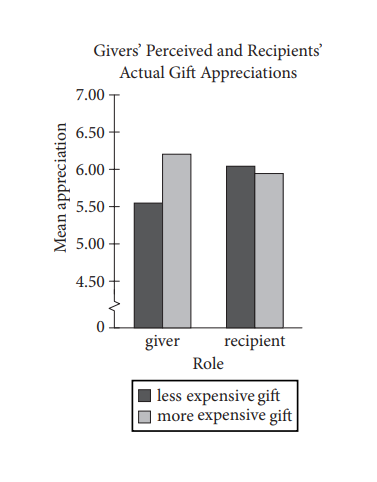SAT (Scholastic Assessment Test) is a standard test, used for taking admission to undergraduate programs of universities or colleges of the United States. SAT is developed and published by the College Board, an organization in the United States, administered by the Educational Testing Service. In this article of AKVTutorials, you will get SAT Practice Test 2 Answers | SAT 2024 Prep Online Classes AMBiPi.
SAT Reading Practice Passage
This passage is adapted from Francis J.Flynn and Gabrielle S.Adams, “Money can’t buy Love: Asymmetric Beliefs about Gift Price and Feelings of Appreciation.” ©2008 by Elsevier Inc.



SAT Reading Comprehension Practice Test Questions
SAT Practice Test 2 Question No 1
The authors most likely use the example in lines 1-9 of the passage (“Every … showers”) to highlight the
Option A: regularity with which people shop for gifts.
Option B: recent increase in the amount of money spent on gifts.
Option C: anxiety gift shopping causes for consumers.
Option D: number of special occasions involving gift-giving.
SAT Practice Test 2 Answer No 1
Show/Hide Answer
Option A :
Lines 1-9 include examples of how many people shop (“millions of shoppers”), how much money they spend (“over
$30 billion at retail stores in December alone”), and the many occasions that lead to shopping for gifts (“including weddings, birthdays, anniversaries, graduations, and baby showers.”). Combined, these examples
show how frequently people in the US shop for gifts.
Choice B is incorrect because even though the authors mention that “$30 billion” had been spent in retail stores in one month, that figure is never discussed as an increase (or a decrease). Choice C is incorrect because lines 1-9 provide a context for the amount of shopping that occurs in the US, but the anxiety (or “dread”) it might cause is not introduced until later in the passage. Choice D is incorrect because lines 1-9 do more than highlight the number of different occasions that lead to gift-giving.
SAT Practice Test 2 Question No 2
In line 10, the word “ambivalent” most nearly means
Option A: unrealistic.
Option B: conflicted.
Option C: apprehensive.
Option D: supportive.
SAT Practice Test 2 Answer No 2
Show/Hide Answer
Option B :
Lines 9-10 state “This frequent experience of gift-giving can engender ambivalent feelings in gift-givers.” In the subsequent sentences, those “ambivalent” feelings are further exemplified as conflicted feelings, as shopping is said to be something that “[m]any relish” (lines 10-11) and “many dread” (line 14).
Choices A, C, and D are incorrect because in this context, “ambivalent” does not mean feelings that are unrealistic, apprehensive, or supportive.
SAT Practice Test 2 Question No 3
The authors indicate that people value gift-giving because they feel it
Option A: functions as a form of self-expression.
Option B: is an inexpensive way to show appreciation.
Option C: requires the gift recipient to reciprocate.
Option D: can serve to strengthen a relationship.
SAT Practice Test 2 Answer No 3
Show/Hide Answer
Option D :
In lines 10-13, the authors clearly state that some people believe gift-giving can help a relationship because it “offers a
powerful means to build stronger bonds with one’s closest peers.”
Choice A is incorrect because even though the authors state that some shoppers make their choices based on “egocentrism,” (line 33) there is no evidence in the passage that people view shopping as a form of self-expression. Choice B is incorrect because the passage implies that shopping is an expensive habit. Choice C is incorrect because the passage states that most people have purchased and received gifts, but it never implies that people are required to reciprocate the gift-giving process.
SAT Practice Test 2 Question No 4
Which choice provides the best evidence for the answer to the previous question?
Option A: Lines 10-13 (“Many … peers”)
Option B: Lines 22-23 (“People … own”)
Option C: Lines 31-32 (“Research … perspectives”)
Option D: Lines 44-47 (“Although … unfounded”)
SAT Practice Test 2 Answer No 4
Show/Hide Answer
Option A :
In lines 10-13, the authors suggest that people value gift-giving because it may strengthen their relationships with others: “Many relish the opportunity to buy presents because gift-giving offers a powerful means to build stronger bonds with one’s closest peers.”
Choices B, C, and D do not provide the best evidence for the answer to the previous question. Choice B is incorrect because lines 22-23 discuss how people often buy gifts that the recipients would not purchase. Choice C is incorrect because lines 31-32 explain how gift-givers often fail to consider the recipients’ preferences. Choice D is incorrect because lines 44-47 suggest that the cost of a gift may not correlate to a recipient’s appreciation of it.
SAT Practice Test 2 Question No 5
The “social psychologists” mentioned in paragraph 2 (lines 17-34) would likely describe the “deadweight loss” phenomenon as
Option A: predictable.
Option B: questionable.
Option C: disturbing.
Option D: unprecedented.
SAT Practice Test 2 Answer No 5
Show/Hide Answer
Option A :
The “deadweight loss” mentioned in the second paragraph is the significant monetary difference between what a gift-giver would pay for something and what a gift-recipient would pay for the same item. That difference would be predictable to social psychologists, whose research “has found that people often struggle to take account of others’
perspectives—their insights are subject to egocentrism, social projection, and multiple attribution errors” (lines 31-34).
Choices B, C, and D are all incorrect because lines 31-34 make clear that social psychologists would expect a disconnect between gift-givers and gift recipients, not that they would question it, be disturbed by it, or find it surprising or unprecedented.
SAT Practice Test 2 Question No 6
The passage indicates that the assumption made by gift-givers in lines 41-44 maybe
Option A: insincere.
Option B: unreasonable.
Option C: incorrect.
Option D: substantiated.
SAT Practice Test 2 Answer No 6
Show/Hide Answer
Option C :
Lines 41-44 suggest that gift-givers assume a correlation between the cost of a gift and how well-received it will be:
“. . . gift-givers equate how much they spend with how much recipients will appreciate the gift (the more expensive the gift, the stronger a gift-recipient’s feelings of appreciation).” However, the authors suggest this assumption may be incorrect or “unfounded” (line 47), as gift recipients “may not construe smaller and larger gifts as representing smaller and larger signals of thoughtfulness and consideration” (lines 63-65).
Choices A, B, and D are all incorrect because the passage neither states nor implies that the gift-giver’s assumption is insincere, unreasonable, or substantiated.
SAT Practice Test 2 Question No 7
Which choice provides the best evidence for the answer to the previous question?
Option A: Lines 53-55 (“Perhaps… consideration”)
Option B: Lines 55-60 (“According… relationship”)
Option C: Lines 63-65 (“As… consideration”)
Option D: Lines 75-78 (“In… relations”)
SAT Practice Test 2 Answer No 7
Show/Hide Answer
Option C :
Lines 63-65 suggest that the assumption made by gift-givers, in lines, 41-44 may be incorrect. The gift-givers assume that recipients will have a greater appreciation for costly gifts than for less costly gifts, but the authors suggest this relationship may be incorrect, as gift-recipients “may not construe smaller and larger gifts as representing smaller and larger signals of thoughtfulness and consideration” (lines 63-65).
Choices A and D are incorrect because lines 53-55 and 75-78 address the question of “why” gift-givers make specific assumptions rather than addressing the validity of these assumptions. Choice B is incorrect because lines 55-60 focus on the reasons people give gifts to others.
SAT Practice Test 2 Question No 8
As it is used in line 54, “convey” most nearly means
Option A: transport.
Option B: counteract.
Option C: exchange.
Option D: communicate.
SAT Practice Test 2 Answer No 8
Show/Hide Answer
Option D :
Lines 53-55 state that “Perhaps givers believe that bigger (i.e., more expensive) gifts convey stronger signals of thoughtfulness and consideration.” In this context, saying that more expensive gifts “convey” stronger signals means the gifts send, or communicate, stronger signals to the recipients.
Choices A, B, and C are incorrect because in this context, to “convey” something does not mean to transport it (physically move something), counteract it (act in opposition to something), or exchange it (trade one thing for another).
SAT Practice Test 2 Question No 9
The authors refer to work by Camerer and others (line 56) in order to
Option A: offer an explanation.
Option B: introduce an argument.
Option C: question a motive.
Option D: support a conclusion.
SAT Practice Test 2 Answer No 9
Show/Hide Answer
Option A :
The paragraph examines how gift-givers believe expensive gifts are more thoughtful than less expensive gifts and will be more valued by recipients. The work of Camerer and others offers an explanation for the gift-givers reasoning: “gift-givers attempt to signal their positive attitudes toward the intended recipient and their willingness to invest resources in a future relationship” (lines 57-60).
Choices B, C, and D are incorrect because the theory articulated by Camerer and others are used to explain an idea put forward by the authors (“givers believe that bigger . . . gifts convey stronger signals”), not to introduce the argument, question a motive or support a conclusion.
SAT Practice Test 2 Question No 10
The graph following the passage offers evidence that gift-givers base their predictions of how much a gift will be appreciated on
Option A: the appreciation level of the gift recipients.
Option B: the monetary value of the gift.
Option C: their desires for the gifts they purchase.
Option D: their relationship with the gift recipients.
SAT Practice Test 2 Answer No 10
Show/Hide Answer
Option B :
The graph clearly shows that gift-givers believe that a “more valuable” gift will be more appreciated than a “less valuable
gift.” According to the graph, gift-givers believe the monetary value of a gift will determine whether that gift is well received or not.
Choice A is incorrect because the graph does not suggest that gift-givers are aware of gift recipients’ appreciation levels. Choices C and D are incorrect because neither the gift-givers desire for the gifts they purchase nor the gift-givers relationship with the gift recipients is addressed in the graph.



